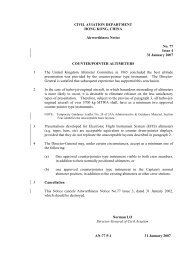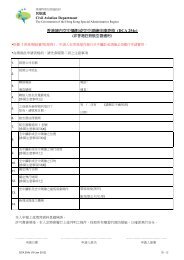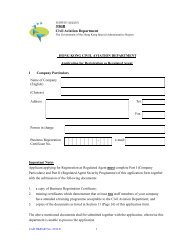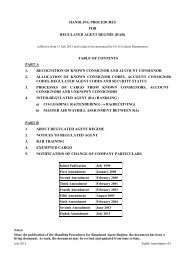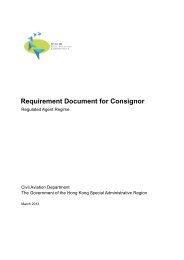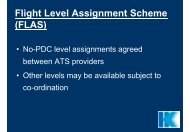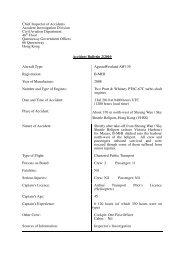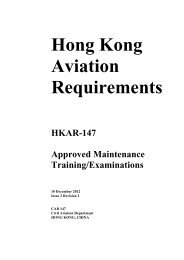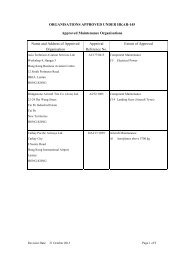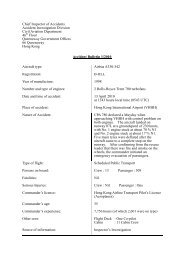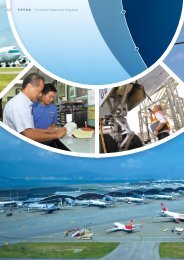Budget 2012-2013 Questions and Answers
Budget 2012-2013 Questions and Answers
Budget 2012-2013 Questions and Answers
- No tags were found...
Create successful ePaper yourself
Turn your PDF publications into a flip-book with our unique Google optimized e-Paper software.
Examination of Estimates of Expenditure <strong>2012</strong>-13 Reply Serial No.SB214CONTROLLING OFFICER’S REPLY TOINITIAL WRITTEN QUESTIONQuestion Serial No.1107Head: 28 Civil Aviation Department Subhead (No. & title):Programme:Controlling Officer:Director of Bureau:(2) Airport St<strong>and</strong>ardsDirector-General of Civil AviationSecretary for SecurityQuestion:Under Matters Requiring Special Attention in <strong>2012</strong>-13, the Civil Aviation Department will review the HongKong Aviation Security Programme vis-à-vis the new edition of the International Civil AviationOrganization Aviation Security Manual. Please provide the details of the work plan <strong>and</strong> resources involvedthis year.Asked by: Hon. LAU Kin-yee, MiriamReply:The International Civil Aviation Organization (ICAO) Aviation Security Manual sets out in detail therequirements which should be complied with by airport operators, aircraft operators <strong>and</strong> other relevantorganisations in implementing aviation security measures. In accordance with the aviation securityrequirements set out by the ICAO <strong>and</strong> the Aviation Security Ordinance (Cap. 494), the Aviation SecurityAuthority (i.e. the Secretary for Security) has drawn up the Hong Kong Aviation Security Programme(HKASP) in collaboration with departments concerned to safeguard aviation operations against acts ofunlawful interference.According to information available to the Civil Aviation Department, the ICAO is updating the AviationSecurity Manual <strong>and</strong> plans to release the new edition in the first half of <strong>2012</strong>. Major new requirementsexpected to be introduced include:(a) enhancing air cargo security further by strengthening the oversight mechanism for known consignors <strong>and</strong>regularising the aviation security requirements to be complied with by known consignors;(b) launching an aviation security instructor certification system in July <strong>2013</strong> to ensure that instructors needto complete the required training before qualifying as aviation security instructors; <strong>and</strong>(c) enhancing the protection of information <strong>and</strong> communication technology systems used for civil aviation tosafeguard against the risk of cyber threats .Session 4SB – page.
Examination of Estimates of Expenditure <strong>2012</strong>-13 Reply Serial No.THB(T)001CONTROLLING OFFICER’S REPLY TOINITIAL WRITTEN QUESTIONQuestion Serial No.0104Head: 28 – Civil Aviation Department Subhead (No. & title):Programme:Controlling Officer:Director of Bureau:(5) Air ServicesDirector-General of Civil AviationSecretary for Transport <strong>and</strong> HousingQuestion:What was the respective percentage of delays of passenger flights to <strong>and</strong> from the Hong Kong InternationalAirport over the past 3 years (i.e. from 2009-10 to 2011-12)? What was the average duration of delay?Which regions (i.e. ports of the arrival flights <strong>and</strong> destinations of the departure flights) were mainly involved?What initiatives are taken by the Administration to minimise flight delays? How will the problem of flightdelays be improved after the third runway is built?Asked by: Hon. CHAN Hak-kanReply:Flight delays are mainly caused by bad weather, restrictions on flight paths <strong>and</strong> airspace, as well asoperational problems of airlines.The percentage of passenger flight delayed at the Hong Kong International Airport (HKIA) <strong>and</strong> the averageduration of delay in the past three years are shown in the table below:YearArrivalsPercentage of delays ofmore than 15 minutes 1Average delay(minute) 2DeparturesPercentage of delays ofmore than 15 minutes 1Average delay(minute) 219%2009-102011-12 3 24%2010-1123%20232115%23%23%1318161: Delay is the difference between the actual aircraft arrival/departure time at the parking st<strong>and</strong> <strong>and</strong> the scheduledflight time.2: The average delay figures represent the average duration of delay of all arrival/departure flights at the HKIA of therespective financial year.3: Figures up to January <strong>2012</strong> (10 months in total)Session 7 THB(T) – page
Examination of Estimates of Expenditure <strong>2012</strong>-13CONTROLLING OFFICER’S REPLY TOINITIAL WRITTEN QUESTIONReply Serial No.THB(T)001Question Serial No.0104The HKIA is always very busy <strong>and</strong> therefore airlines are required to operate according to their flightschedules after obtaining the slots allocated by the Civil Aviation Department (CAD). CAD keeps a closewatch on airlines’ on-time performance. If an airline is found to have operated its services with significant<strong>and</strong> frequent delays without reasonable explanations, CAD will issue warnings to the airline concerned. Ifthere is no improvement in the airline’s performance, CAD will assign a lower priority to its future slotrequests in accordance with international guidelines.In the past three years, the number of flights registered an average increase of about 5 %, but the situation offlight delays remained largely the same. Also, flight information did not show significant delays of arrivalflights <strong>and</strong> departure flights involving any particular regions.The Airport Authority consulted the public on HKIA Master Plan 2030 in mid-2011 <strong>and</strong> reported to theGovernment in the end of 2011. It was suggested that the third runway option should be adopted as theairport’s future development plan, <strong>and</strong> to proceed with further planning work. If the third runway option isimplemented, it will help to enhance the airport’s capacity.Signature:Name in block letters:Post Title:NORMAN LODirector-General of Civil AviationDate: 23.2.<strong>2012</strong>Session 7 THB(T) – page
Examination of Estimates of Expenditure <strong>2012</strong>-13 Reply Serial No.THB(T)002CONTROLLING OFFICER’S REPLY TOINITIAL WRITTEN QUESTIONQuestion Serial No.2844Head: 28 Civil Aviation Department Subhead (No. & title):Programme:Controlling Officer:Director of Bureau:(3) Air Traffic ManagementDirector-General of Civil AviationSecretary for Transport <strong>and</strong> HousingQuestion:What is the Department’s estimated expenditure on the training of air traffic control staff? Is therecurrently any shortage of such staff? What is the estimated expenditure on the salaries of air traffic controlstaff in <strong>2012</strong>-13?Asked by: Hon. CHAN TanyaReply:In the past 5 years, the Civil Aviation Department (CAD) recruited a total of 120 Student Air Traffic ControlOfficers (SATCOs). It is expected that they will gradually obtain their air traffic controller licence in thenext few years to discharge air traffic control (ATC) duties. Our current staffing is adequate.CAD will review the need to recruit ATC staff in a timely <strong>and</strong> regular manner in the light of the futuredevelopment of the Hong Kong International Airport. CAD will continue to train up its ATC staff. In<strong>2012</strong>-13, the estimated expenditure on such training is $16.78 million, which is 24% higher than that of2011-12.In terms of notional annual mid-point salary value, the estimated annual staff costs of the ATC staffestablishment in <strong>2012</strong>-13 is $219 million.Signature:Name in block letters:Post Title:NORMAN LODirector-General of Civil AviationDate: 23.2.<strong>2012</strong>Session 7 THB(T) – page
Examination of Estimates of Expenditure <strong>2012</strong>-13 Reply Serial No.THB(T)003CONTROLLING OFFICER’S REPLY TOINITIAL WRITTEN QUESTIONQuestion Serial No.2845Head: 28 Civil Aviation Department Subhead (No. & title):Programme:Controlling Officer:Director of Bureau:(3) Air Traffic ManagementDirector-General of Civil AviationSecretary for Transport <strong>and</strong> HousingQuestion:According to the Department, the declared runway capacity of the Hong Kong International Airport willreach 63 movements per hour in <strong>2012</strong>. Will this have any impact on the workload of the existing air trafficcontrol staff? Will the estimated hourly operational costs of the Department increase as a result? What is theestimated increase?Asked by: Hon. CHAN TanyaReply:To tie in with the increased runway capacity of the Hong Kong International Airport from 62 to 63movements per hour, the Civil Aviation Department (CAD) has made enhancements to differentaspects of air traffic control (ATC) operations, including:(a)(b)streamlining ATC procedures to segregate arrival flights from transit flights; <strong>and</strong>adjusting radar control sectors <strong>and</strong> the associated air traffic operating procedures to balancethe workload of the control sectors.These procedural enhancements enable the existing ATC systems to fully support the traffic volumeof 63 movements per hour. The relevant work is undertaken by CAD’s existing staff as part oftheir normal duties under Programme (3) <strong>and</strong> there are no additional expenses involved.Signature:Name in block letters:Post Title:NORMAN LODirector-General of Civil AviationDate: 23.2.<strong>2012</strong>Session 7 THB(T) – page
Examination of Estimates of Expenditure <strong>2012</strong>-13 Reply Serial No.THB(T)004CONTROLLING OFFICER’S REPLY TOINITIAL WRITTEN QUESTIONQuestion Serial No.2846Head: 28 Civil Aviation Department Subhead (No. & title):Programme:Controlling Officer:Director of Bureau:(4) Air Traffic Engineering <strong>and</strong> St<strong>and</strong>ardsDirector-General of Civil AviationSecretary for Transport <strong>and</strong> HousingQuestion:What are the details of the replacement plan for the radar, navigational aids <strong>and</strong> radio communicationsystems of the Civil Aviation Department (CAD) in <strong>2012</strong>? How can the CAD ensure that the daily aircraftmovements will not be affected during the replacement period? What is the additional expenditureinvolved?Asked by: Hon. CHAN TanyaReply:The Civil Aviation Department (CAD) has undertaken studies on the replacement of radar, navigational aids<strong>and</strong> radio communication systems <strong>and</strong> has sought the views of the industry to ensure that the replacementwill dovetail with their work <strong>and</strong> development plans. CAD will conduct further market surveys in <strong>2012</strong>-13to work out the replacement details as well as the estimated expenditure. In the course of replacement,CAD will take note of the capability of the new air traffic control systems being replaced to ensure moredetailed <strong>and</strong> accurate flight information can be provided. CAD will also set out appropriate replacementprocedures to ensure that the impact on daily aircraft movements will be kept to the minimum.Signature:Name in block letters:Post Title:NORMAN LODirector-General of Civil AviationDate: 23.2.<strong>2012</strong>Session 7 THB(T) – page
Examination of Estimates of Expenditure <strong>2012</strong>-13 Reply Serial No.THB(T)005CONTROLLING OFFICER’S REPLY TOINITIAL WRITTEN QUESTIONQuestion Serial No.3150Head: 28 Civil Aviation Department Subhead (No. & title):Programme:Controlling Officer:Director of Bureau:(3) Air Traffic ManagementDirector-General of Civil AviationSecretary for Transport <strong>and</strong> HousingQuestion:Since the runway capacity of the airport is currently subject to restrictions on civil aviation airspace, will theGovernment deploy resources for negotiation with the Mainl<strong>and</strong> authorities on releasing airspace?Asked by: Hon. CHAN TanyaReply:The geographical constraints surrounding the Hong Kong International Airport, such as Lantau Isl<strong>and</strong> to thesouth, Castle Peak to the north <strong>and</strong> Tai Mo Shan to the northeast, are the major restrictions on its runwaycapacity. The maximum capacity of the two-runway system is 68 movements per hour. According to ourplan, the Civil Aviation Department (CAD) will increase the runway capacity from the current level of 62movements per hour to 63 movements per hour by March <strong>2012</strong>, <strong>and</strong> progressively to 68 movements per hourby 2015.Over the years, CAD has actively follow up with the civil aviation authorities of the Mainl<strong>and</strong> <strong>and</strong> Macao onimproving the use of airspace <strong>and</strong> air traffic management efficiency in the Pearl River Delta (PRD) region tocater for air traffic growth in the region. During <strong>2012</strong>-13, CAD will continue to participate in regulardiscussions through the tripartite working group on resolving PRD air routes <strong>and</strong> airspace issues. Suchtasks include improving <strong>and</strong> coordinating the use of airspace in the PRD Region. The above co-ordinationwork is undertaken by existing CAD staff as part of their normal duties <strong>and</strong> no additional expenses areinvolved.Signature:Name in block letters:Post Title:NORMAN LODirector-General of Civil AviationDate: 23.2.<strong>2012</strong>Session 7THB(T) – page no.
Examination of Estimates of Expenditure <strong>2012</strong>-13 Reply Serial No.THB(T)006CONTROLLING OFFICER’S REPLY TOINITIAL WRITTEN QUESTIONQuestion Serial No.3151Head: 28 Civil Aviation Department Subhead (No. & title):Programme:Controlling Officer:Director of Bureau:(3) Air Traffic ManagementDirector-General of Civil AviationSecretary for Transport <strong>and</strong> HousingQuestion:The Government indicates that the runway capacity will be increased to 63 movements per hour in <strong>2012</strong>.How many resources has the Government allocated for conducting studies on how to enhance the runwaycapacity?Asked by: Hon. CHAN TanyaReply:Studies on enhancement of runway capacity are conducted by the Civil Aviation Department as part of itsnormal duties under Programme (3). There are no additional expenses involved.Signature:Name in block letters:Post Title:NORMAN LODirector-General of Civil AviationDate: 23.2.<strong>2012</strong>Session 7 THB(T)– page no.
Examination of Estimates of Expenditure <strong>2012</strong>-13 Reply Serial No.THB(T)007CONTROLLING OFFICER’S REPLY TOINITIAL WRITTEN QUESTIONQuestion Serial No.3152Head: 28 Civil Aviation Department Subhead (No. & title):Programme:Controlling Officer:Director of Bureau:(3) Air Traffic ManagementDirector-General of Civil AviationSecretary for Transport <strong>and</strong> HousingQuestion:What measures did the Government take to review the air transport dem<strong>and</strong> forecasts in 2011-12 <strong>and</strong> howmuch resources were allocated for this purpose? Will the Government set aside resources for conductingair transport dem<strong>and</strong> forecasts in this financial year? If yes, will it conduct an independent study or makereference to the information provided by the Airport Authority?Asked by: Hon. CHAN TanyaReply:In determining the air transport dem<strong>and</strong> forecasts, the Civil Aviation Department (CAD) has made referenceto the forecasts by international aviation organisations (such as International Civil Aviation Organization <strong>and</strong>International Air Transport Association) <strong>and</strong> the Airport Authority on air traffic capacity at Hong KongInternational Airport. CAD also considers other factors which may have impacts on the development ofcivil aviation, including global <strong>and</strong> regional economic outlooks. In <strong>2012</strong>-13, CAD will continue to takevarious factors into account in assessing the air traffic dem<strong>and</strong>.The above work is undertaken by CAD’s existing staff as part of their normal duties under Programme (3)<strong>and</strong> there are no additional expenses involved.Signature:Name in block letters:Post Title:NORMAN LODirector-General of Civil AviationDate: 23.2.<strong>2012</strong>Session 7 THB(T) – page
Examination of Estimates of Expenditure <strong>2012</strong>-13 Reply Serial No.THB(T)008CONTROLLING OFFICER’S REPLY TOINITIAL WRITTEN QUESTIONQuestion Serial No.1377Head: 28 – Civil Aviation Department Subhead (No. & title):Programme:Controlling Officer:Director of Bureau:(5) Air ServicesDirector-General of Civil AviationSecretary for Transport <strong>and</strong> HousingQuestion:The Administration has indicated that it will monitor the noise <strong>and</strong> flight tracks of aircraft, <strong>and</strong> implementthe noise abatement programme in <strong>2012</strong>-13. Will the Administration inform this Committee:(a)(b)(c)(d)of the details of the above measures <strong>and</strong> the expenditure to be involved;of the reasons for failing to solve the problem of aircraft noise at root over the years;whether it will set st<strong>and</strong>ards to assess the effectiveness of noise abatement measures; <strong>and</strong>whether it will provide information about aircraft noise at various times in different months, includingthe noise exposure forecast (NEF) contour maps at various times each month, so that the public willunderst<strong>and</strong> better the scope of aircraft noise impact at various times. If yes, what are the details? Ifnot, what are the reasons?Asked by: Hon. CHAN Wai-yip, AlbertReply:(a) The Civil Aviation Department (CAD) has devised a number of aircraft noise abatement measuresfollowing the policies of the International Civil Aviation Organization (ICAO):(i)(ii)(iii)between midnight <strong>and</strong> 07:00 am, subject to acceptable operational <strong>and</strong> safety consideration,arriving aircraft are required to l<strong>and</strong> from the southwest. This measure aims to reduce thenumber of aircraft overflying populated areas like Shatin, Tsuen Wan, Sham Tseng <strong>and</strong> TsingLung Tau;aircraft departing to the northeast of the airport between 11:00 pm <strong>and</strong> 07:00 am, subject toacceptable operational <strong>and</strong> safety consideration are required to use the southbound route viathe West Lamma Channel. This measure aims to reduce the number of aircraft overflyingpopulated areas like the Kowloon Peninsula <strong>and</strong> Hong Kong Isl<strong>and</strong>;to reduce the noise impact on areas located in the vicinity of the airport, aircraft departing tothe northeast of the airport are required to adopt the noise abatement take-off procedures.Under these procedures, aircraft are required to reduce their power upon reaching an altitude of800 feet or above to abate aircraft noise;Session 7 THB (T) – page
Examination of Estimates of Expenditure <strong>2012</strong>-13 Reply Serial No.THB(T)008CONTROLLING OFFICER’S REPLY TOINITIAL WRITTEN QUESTIONQuestion Serial No.1377(iv)all aircraft on approach to the airport from the northeast between 11:00 pm <strong>and</strong> 07:00 am,subject to operational consideration, are encouraged to adopt the Continuous DescentApproach (CDA). As aircraft on CDA fly higher <strong>and</strong> normally on a low power/low dragconfiguration, noise experienced in areas such as Sai Kung <strong>and</strong> Ma On Shan will be lowered;<strong>and</strong>(v) to abate aircraft noise at source, only aircraft complying with the noise st<strong>and</strong>ards in Chapter 3of Part II, Volume I, Annex 16 to the Convention on International Civil Aviation <strong>and</strong> the CivilAviation (Aircraft Noise) Ordinance (Chapter 312) are allowed to operate in Hong Kong.This measure is comparable to other major international airports. Our latest statistics indicatethat a number of airlines have started using quieter passenger <strong>and</strong> cargo aircraft such as B777-300ER, A330-200, A380, B777-200F <strong>and</strong> B747-8F. CAD will continue to follow up <strong>and</strong>communicate actively with airline operators in this regard.Following the development of satellite-based navigation technology, CAD commissioned aconsultancy study earlier on which recommended the use of the technology to help reduce aircraft noiseimpact on residents of Ma Wan. The relevant flight procedures have been adopted since February<strong>2012</strong>.CAD also monitors the noise generated by aircraft along the flight paths by a computerised AircraftNoise <strong>and</strong> Flight Track Monitoring System (ANFTMS). The ANFTMS comprises 16 outdoor noisemonitoring terminals (NMTs) which are located along or close to the flight paths operating into <strong>and</strong> outof the Hong Kong International Airport (HKIA) <strong>and</strong> a computer to associate the noise data with theaircraft flight tracks recorded by CAD’s radar system. The NMTs are located at Sha Lo Wan, TungChung, Sunny Bay, Tai Lam Chung, Tsing Lung Tau, Ma Wan, Ting Kau, West Tsuen Wan, Tsing Yi(two stations), Kwai Chung, Tai Wai, the Mid-levels, Jardine’s Lookout, North Point <strong>and</strong> Shaukeiwan.The estimated expenditure for the maintenance of the ANFTMS is $2.1 million in <strong>2012</strong>-13. Theimplementation of the above noise abatement measures is undertaken by CAD’s existing staff as part oftheir regular duties under Programme (5).(b) The flight paths for aircraft operating to/from the HKIA are developed after taking into account therunway alignment, terrain environment, obstacle clearances etc. Since Hong Kong is a small <strong>and</strong>densely populated city, aircraft cannot completely avoid residential areas. Based on our observations,the noise abatement measures are effective to a certain extent.(c) The noise abatement measures are devised according to international st<strong>and</strong>ards <strong>and</strong> the guidelinespromulgated by the ICAO. CAD will continue to monitor the international development of suchmeasures.(d)After we have consolidated the noise data collected from the ANFTMS, we will upload the informationregularly onto CAD’s website. The Noise Exposure Forecast (NEF) contour is used to forcast theimpact of aircraft noise on the areas in the vicinity of the airport for l<strong>and</strong> use planning purposes basedon the maximum design capacity of the airport. It does not measure or monitor the daily noise level ofaircraft. The Airport Authority will set the Noise Exposure Forecast contour whenever necessary in thelight of the development of the airport.Session 7 THB (T) – page
Examination of Estimates of Expenditure <strong>2012</strong>-13CONTROLLING OFFICER’S REPLY TOINITIAL WRITTEN QUESTIONReply Serial No.THB(T)008Question Serial No.1377Signature:Name in block letters:Post Title:NORMAN LODirector-General of Civil AviationDate: 23.2.<strong>2012</strong>Session 7 THB (T) – page
Examination of Estimates of Expenditure <strong>2012</strong>-13 Reply Serial No.THB(T)009CONTROLLING OFFICER’S REPLY TOINITIAL WRITTEN QUESTIONQuestion Serial No.0686Head: 28 Civil Aviation Department Subhead (No. & title):Programme:Controlling Officer:Director of Bureau:(3) Air Traffic ManagementDirector-General of Civil AviationSecretary for Transport <strong>and</strong> HousingQuestion:According to an independent report released in late 2011 by the Social Sciences Research Centre of theUniversity of Hong Kong, members of the public have shown a clear preference for the development of athree-runway system in the airport expansion project to meet the city’s long-term air traffic dem<strong>and</strong>.The future expansion of the Hong Kong International Airport will bring about an increase in the dem<strong>and</strong> forair traffic control staff. Does the Civil Aviation Department have any plan for the provision of training torelevant staff in the <strong>2012</strong>-13 financial year? If so, what are the estimated expenditure <strong>and</strong> details of theplan? If not, what are the reasons?Asked by: Hon. HO Chung-tai, RaymondReply:In the past 5 years, the Civil Aviation Department (CAD) recruited a total of 120 Student Air Traffic ControlOfficers (SATCOs). It is expected that they will gradually obtain their air traffic controller licence in thenext few years to discharge air traffic control (ATC) duties. As our current staffing is adequate, there is noneed to recruit any SATCOs in <strong>2012</strong>-13.CAD will review the need to recruit ATC staff in a timely <strong>and</strong> regular manner in the light of the futuredevelopment of the Hong Kong International Airport. CAD will continue to train up its ATC staff. In<strong>2012</strong>-13, the estimated expenditure on such training is $16.78 million, which is 24% higher than that of2011-12.Signature:Name in block letters:Post Title:NORMAN LODirector-General of Civil AviationDate: 23.2.<strong>2012</strong>Session 7 THB(T) – page
Examination of Estimates of Expenditure <strong>2012</strong>-13 Reply Serial No.THB(T)010CONTROLLING OFFICER’S REPLY TOINITIAL WRITTEN QUESTIONQuestion Serial No.1327Head: 28 – Civil Aviation Department Subhead (No. & title): 000 Operational ExpensesProgramme:Controlling Officer:Director of Bureau:(3) Air Traffic ManagementDirector-General of Civil AviationSecretary for Transport <strong>and</strong> HousingQuestion:(a)How many civil service staff will the Administration recruit in <strong>2012</strong>-13? Please give a breakdown bygrade <strong>and</strong> rank. What is the expenditure involved?(b) What are the duties of Student Air Traffic Control Officers of the Civil Aviation Department (CAD)<strong>and</strong> Aerodrome Control Trainees of the Airport Authority (AA)? Why does the CAD not recruitAerodrome Control Trainees directly by itself?(c)Does the Administration plan to replace the CAD’s Student Air Traffic Control Officer grade with theAA’s Aerodrome Control Trainees? If yes, what are the details? Why does the Administration havesuch a plan?Asked by: Hon. IP Wai-mingReply:(a)In <strong>2012</strong>-13, the Civil Aviation Department (CAD) plans to recruit 6 additional civil servants to meet therequirements of the new posts. The annual staff costs of these posts, in terms of notional annual midpointsalary value, are $2.28 million. The details are as follows:Grade Rank Number $ (million)Operations Officer Operations Officer 2 1.43Air Traffic Flight Services Air Traffic Flight Services 4 0.85OfficerOfficer III6 2.28(b) Student Air Traffic Control Officers need to receive comprehensive training in order to obtain the airtraffic controller licence, <strong>and</strong> discharge duties in different control positions (including the aerodromecontrol positions <strong>and</strong> the radar control positions in the Air Traffic Control Centre). The whole processtakes 5 to 6 years. Aerodrome Control Trainees of the Airport Authority are not civil servants <strong>and</strong> aretrained mainly for carrying out aerodrome control duties. The recruitment of Aerodrome ControlTrainees can facilitate CAD in deploying human resources effectively to cope with the sustainedgrowth in the runway capacity.(c)CAD has no plan to replace the Student Air Traffic Control Officer posts with the Aerodrome ControlTrainee posts. CAD will also continue to review the staffing needs regularly in order to cope with thegrowth in aircraft movements.Session 7 THB(T) – page
Examination of Estimates of Expenditure <strong>2012</strong>-13CONTROLLING OFFICER’S REPLY TOINITIAL WRITTEN QUESTIONReply Serial No.THB(T)010Question Serial No.1327Signature:Name in block letters:Post Title:NORMAN LODirector-General of Civil AviationDate: 23.2.<strong>2012</strong>Session 7 THB(T) – page
Examination of Estimates of Expenditure <strong>2012</strong>-13 Reply Serial No.THB(T)011CONTROLLING OFFICER’S REPLY TOINITIAL WRITTEN QUESTIONQuestion Serial No.1106Head: 28 – Civil Aviation Department Subhead (No. & title):Programme:Controlling Officer:Director of Bureau:(2) Airport St<strong>and</strong>ardsDirector-General of Civil AviationSecretary for Transport <strong>and</strong> HousingQuestion:With regard to the number of inspections of shippers, freight forwarders, airlines <strong>and</strong> ground h<strong>and</strong>ling agentsin respect of their dangerous goods h<strong>and</strong>ling st<strong>and</strong>ards, the target number is 45, the actual numbers in 2010<strong>and</strong> 2011 were 47 <strong>and</strong> 45 respectively, while the planned number for <strong>2012</strong> is 46. In this connection, pleaseadvise on:(a) the basis for setting the target number at 45;(b) the reason for the change in the number of inspections;(c) the details of such inspections;(d) the amount of provision required for such purpose in this financial year.Asked by: Hon. LAU Kin-yee, MiriamReply:(a) The target number of annual inspections depends mainly on the level of risk assessed. Therisk factors to be considered include the number of new regulated operators, findings of annualaudits/inspections, types <strong>and</strong> volume of the dangerous goods processed by the operators, pastincidents of dangerous goods, etc.(b) The numbers of inspections (47, 45 <strong>and</strong> 46) in 2010, 2011 (actual) <strong>and</strong> <strong>2012</strong> (estimate) aremore or less the same. The main reason for the variation is that some organisations were notavailable for inspection on the pre-arranged dates in a particular year.(c) The details of such inspections include:(i)(ii)auditing Hong Kong registered aircraft operators with dangerous goods permission;auditing training organisations with dangerous goods training approval;(iii) inspecting shippers of dangerous goods <strong>and</strong> freight forwarders on dangerous goodstraining of their staff <strong>and</strong> their h<strong>and</strong>ling procedures of dangerous goods for carriage byair; <strong>and</strong>(iv) inspecting local <strong>and</strong> overseas aircraft operators on their loading procedures ofdangerous goods.Session 7 THB – page
Examination of Estimates of Expenditure <strong>2012</strong>-13CONTROLLING OFFICER’S REPLY TOINITIAL WRITTEN QUESTIONReply Serial No.THB(T)011Question Serial No.1106(d) Since the inspections are undertaken by the Civil Aviation Department as part of its normalduties under Programme (2), there are no additional expenses involved.Signature:Name in block letters:Post Title:NORMAN LODirector-General of Civil AviationDate: 23.2.<strong>2012</strong>Session 7 THB – page
Examination of Estimates of Expenditure <strong>2012</strong>-13 Reply Serial No.THB(T)012CONTROLLING OFFICER’S REPLY TOINITIAL WRITTEN QUESTIONQuestion Serial No.1108Head: 28 Civil Aviation Department Subhead (No. & title):Programme:Controlling Officer:Director of Bureau:(2) Airport St<strong>and</strong>ardsDirector-General of Civil AviationSecretary for Transport <strong>and</strong> HousingQuestion:Under Matters Requiring Special Attention in <strong>2012</strong>-13, the Civil Aviation Department will monitor theInternational Civil Aviation Organization’s latest st<strong>and</strong>ards on carriage of dangerous goods by air. Pleaseprovide the details of the work plan <strong>and</strong> the resources involved this year.Asked by: Hon.LAU Kin-yee, MiriamReply:The Technical Instructions for the Safe Transport of Dangerous Goods By Air (the Technical Instructions),published by the International Civil Aviation Organization (ICAO), contains detailed requirements forcompliance by aircraft operators, shippers <strong>and</strong> freight forwarders to ensure safe carriage of dangerous goodsby air. In <strong>2012</strong>-13, the ICAO will amend the Technical Instructions to strengthen control on the transportof lithium batteries. In this connection, the Department will conduct a review to ensure all the partiesinvolved will comply with the latest safety requirements. As the review is undertaken by existing staff aspart of their normal duties under Programme (2), there are no additional expenses involved.Signature:Name in block letters:Post Title:NORMAN LODirector-General of Civil AviationDate: 23.2.<strong>2012</strong>Session 7 THB (T) – page no.*
Examination of Estimates of Expenditure <strong>2012</strong>-13 Reply Serial No.THB(T)013CONTROLLING OFFICER’S REPLY TOINITIAL WRITTEN QUESTIONQuestion Serial No.1109Head: 28 Civil Aviation Department Subhead (No. & title):Programme:Controlling Officer:Director of Bureau:(3) Air Traffic ManagementDirector-General of Civil AviationSecretary for Transport <strong>and</strong> HousingQuestion:The estimated numbers of aircraft transiting Hong Kong Flight Information Region (HKFIR) in 2010 <strong>and</strong>2011 were 148 400 <strong>and</strong> 169 500, however, the actual figures turned out to be 161 437 <strong>and</strong> 184 842respectively. The deviation rate was about 9%. Such deviation was due to the air traffic growth as aresult of economic growth in the Asia Pacific Region. In <strong>2012</strong>, the estimated number of aircraft transitingHKFIR is 185 000. Given the present unstable global economic condition, is the estimation too optimistic?What are the data used for making such estimation? Does the authority have any plans <strong>and</strong> targets to raisethe capacity of HKFIR?Asked by: Hon. LAU Kin-yee, MiriamReply:In projecting the annual aircraft movements, the Civil Aviation Department (CAD) has made reference to theforecasts published by international aviation organisations (e.g. International Civil Aviation Organization,International Air Transport Association, etc.) <strong>and</strong> other factors that may have impacts on the development ofcivil aviation, which include global <strong>and</strong> regional economic outlooks, etc. Having considered the abovefactors, CAD anticipates that there will not be substantial uplift in the number of aircraft transiting HKFIR in<strong>2012</strong>. Hence, the estimated figure is 185 000, which is comparable to the actual number of aircrafttransiting HKFIR in 2011.To raise the capacity of HKFIR, CAD will continue to refine air traffic operating procedures with a view tofurther optimising the relevant operations <strong>and</strong> enhancing the airspace h<strong>and</strong>ling capacity. CAD willcommence the research project on the establishment of “upper radar control sectors” in <strong>2012</strong> in a bid tostrengthen the capacity of air traffic control units in h<strong>and</strong>ling traffic transiting HKFIR during peak hours.In addition, CAD will also review the airspace structure of the western HKFIR to enhance the overall airtraffic control efficiency. It is anticipated that there is a need to establish new radar control sectors withinHKFIR to ensure sufficient capacity to cope with the traffic growth <strong>and</strong> a safe <strong>and</strong> smooth air traffic controloperation.Signature:Name in block letters:Post Title:NORMAN LODirector-General of Civil AviationDate: 28.2.<strong>2012</strong>Session 7 THB(T) – page no.
Examination of Estimates of Expenditure <strong>2012</strong>-13 Reply Serial No.THB(T)014CONTROLLING OFFICER’S REPLY TOINITIAL WRITTEN QUESTIONQuestion Serial No.1110Head: 28 – Civil Aviation Department Subhead (No. & title):Programme:Controlling Officer:Director of Bureau:(3) Air Traffic ManagementDirector-General of Civil AviationSecretary for Transport <strong>and</strong> HousingQuestion:Regarding the work to continue co-ordination with neighbouring Area Control Centres to rationalise <strong>and</strong>optimise the airspace design of the Pearl River Delta region, please inform this Committee of the specificwork plan, objectives <strong>and</strong> resources involved in <strong>2012</strong>-13.Asked by: Hon. LAU Kin-yee, MiriamReply:A tripartite working group, comprising the civil aviation authorities of the Mainl<strong>and</strong>, Hong Kong <strong>and</strong> Macao,was established in 2004 to devise short-term <strong>and</strong> long-term measures to enhance the airspace design <strong>and</strong>increase air route capacities in the Pearl River Delta (PRD) region. The enhancement measures, based onthe principles of joint airspace planning, use of common st<strong>and</strong>ards, <strong>and</strong> harmonised flight procedure design,are to be implemented in phases.In the past year, we continued to co-ordinate with the neighbouring Area Control Centres (ACCs) to improvethe use of airspace in the PRD region. Through the collaborative efforts of the three sides, the followingmeasures were implemented in 2011 to enhance management efficiency in the PRD region:(a) The Zhuhai Terminal Area was adjusted in April 2011 to enhance the airspace capacity <strong>and</strong>operational efficiency; <strong>and</strong>(b) An additional h<strong>and</strong>over point between the Hong Kong <strong>and</strong> the Guangzhou Flight InformationRegions was established in September 2011. This measure reduces significantly the trafficcomplexity in the airspace around the Hong Kong International Airport, thereby enhancingairspace management efficiency.In <strong>2012</strong>-13, the Civil Aviation Department (CAD) will continue to participate in regular discussions throughthe tripartite working group on resolving PRD air routes <strong>and</strong> airspace issues . Such tasks include improving<strong>and</strong> coordinating the use of airspace in the PRD region.The above co-ordination work is undertaken by existing CAD staff as part of their normal duties <strong>and</strong> noadditional expenses are involved.Session 7 THB – page no.
Examination of Estimates of Expenditure <strong>2012</strong>-13CONTROLLING OFFICER’S REPLY TOINITIAL WRITTEN QUESTIONReply Serial No.THB(T)014Question Serial No.1110Signature:Name in block letters:Post Title:NORMAN LODirector-General of Civil AviationDate: 23.2.<strong>2012</strong>Session 7 THB – page no.
Examination of Estimates of Expenditure <strong>2012</strong>-13 Reply Serial No.THB(T)015CONTROLLING OFFICER’S REPLY TOINITIAL WRITTEN QUESTIONQuestion Serial No.1111Head: 28 – Civil Aviation Department Subhead (No. & title):Programme:Controlling Officer:Director of Bureau:(3) Air Traffic ManagementDirector-General of Civil AviationSecretary for Transport <strong>and</strong> HousingQuestion:The Civil Aviation Department will increase the runway capacity of the Hong Kong International Airportfrom 62 movements per hour in 2011 to 63 movements per hour in <strong>2012</strong>, a mere increase of 1 movement perhour. Whereas over the past 3 years, there had been an increase of 2 movements per hour every year from58 movements per hour in 2009 to 62 movements per hour in 2011. What is the reason for the deceleratinggrowth? Can the target of increasing the runway capacity to 68 movements per hour by 2015 be achieved?Asked by: Hon. LAU Kin-yee, MiriamReply:The Civil Aviation Department (CAD) maintains close <strong>and</strong> continual liaision with airline operators on airtraffic dem<strong>and</strong> forecast. At present, the runway capacity of the Hong Kong International Airport (HKIA) is62 movements per hour. According to available information, this capacity has fully catered for the trafficdem<strong>and</strong> from airline operators during the major operating period (i.e. 8 a.m. to 11 p.m.). The currentrunway slot utilisation rate is 84% on average, which means that there is still 16% available to h<strong>and</strong>le futuregrowth.Having taken into account all possible factors affecting aviation development, including global <strong>and</strong> regionaleconomic outlook, CAD foresees a slackening growth in air traffic. CAD will continue to implementenhancement measures to optimise runway capacity, which will be increased to 63 movements per hour in<strong>2012</strong>-13. This, together with the remaining available capacity, is expected to be able to meet the air trafficdem<strong>and</strong>.CAD will, in collaboration with the Airport Authority, continue to implement various measures to enhanceair traffic management <strong>and</strong> airfield operation, including the opening of the new Air Traffic Control Centre bythe end of <strong>2013</strong>. It is anticipated that the runway capacity will be progressively increased to 68 movementsper hour in 2015 as planned.Signature:Name in block letters:Post Title:NORMAN LODirector-General of Civil AviationDate: 23.2.<strong>2012</strong>Session 7 THB(T) – page
Examination of Estimates of Expenditure <strong>2012</strong>-13 Reply Serial No.THB(T)016CONTROLLING OFFICER’S REPLY TOINITIAL WRITTEN QUESTIONQuestion Serial No.1112Head: 28 Civil Aviation Department Subhead (No. & title):Programme:Controlling Officer:Director of Bureau:(3) Air Traffic ManagementDirector-General of Civil AviationSecretary for Transport <strong>and</strong> HousingQuestion:What is the estimated number of air traffic controllers to be recruited in <strong>2012</strong>-13? How many of them arerecruited to fill up vacancies? How many new posts are created because of an increase in workload?What is the expenditure to be involved? What are the training costs for air traffic controllers?Asked by: Hon. LAU Kin-yee, MiriamReply:In the past 5 years, the Civil Aviation Department (CAD) recruited a total of 120 Student Air Traffic ControlOfficers (SATCOs). It is expected that they will gradually obtain their air traffic controller licence in thenext few years to discharge air traffic control (ATC) duties. As our current staffing is adequate, there is noneed to recruit any SATCOs in <strong>2012</strong>-13.CAD will review the need to recruit ATC staff in a timely <strong>and</strong> regular manner in the light of the futuredevelopment of the Hong Kong International Airport. CAD will continue to train up its ATC staff. In<strong>2012</strong>-13, the estimated expenditure on such training is $16.78 million, which is 24% higher than that of2011-12.Signature:Name in block letters:Post Title:NORMAN LODirector-General of Civil AviationDate: 23.2.<strong>2012</strong>Session 7 THB(T) – page
Examination of Estimates of Expenditure <strong>2012</strong>-13 Reply Serial No.THB(T)017CONTROLLING OFFICER’S REPLY TOINITIAL WRITTEN QUESTIONQuestion Serial No.1113Head: 28 – Civil Aviation Department Subhead (No. & title):Programme:Controlling Officer:Director of Bureau:(5) Air ServicesDirector-General of Civil AviationSecretary for Transport <strong>and</strong> HousingQuestion:The Civil Aviation Department will continue to provide support to the negotiation <strong>and</strong> implementation ofHong Kong’s air services agreements <strong>and</strong> promote Hong Kong as an international <strong>and</strong> regional aviationcentre. In this regard, what are the objectives of the work involved <strong>and</strong> the resources to be incurred in<strong>2012</strong>-13?Asked by: Hon. LAU Kin-yee, MiriamReply:In <strong>2012</strong>-13, the Civil Aviation Department (CAD) will continue to assist the Transport <strong>and</strong> Housing Bureauin negotiations on air services agreements (ASAs) with Hong Kong's aviation partners by providing adviceon technical issues relating to aviation safety <strong>and</strong> security, as well as on the utilization of traffic rights byairlines in operating air services to <strong>and</strong> from Hong Kong. CAD will also continue to provide support in theimplementation of the ASAs by facilitating the operation of air services by airlines <strong>and</strong> monitoringcompliance with the relevant provisions of the ASAs.In relation to the above, we estimate that in <strong>2012</strong> about 140 scheduled <strong>and</strong> 1 100 non-scheduled air servicespermits will be issued respectively, <strong>and</strong> about 2 500 tariff filings will be processed.The above services are undertaken by CAD’s existing staff as part of their normal duties under Programme(5) <strong>and</strong> there are no additional expenses involved.Signature:Name in block letters:Post Title:NORMAN LODirector-General of Civil AviationDate: 23.2.<strong>2012</strong>Session 7 THB(T) – page
Examination of Estimates of Expenditure <strong>2012</strong>-13 Reply Serial No.THB(T)018CONTROLLING OFFICER’S REPLY TOINITIAL WRITTEN QUESTIONQuestion Serial No.0278Head: 28 – Civil Aviation Department Subhead (No. & title):Programme:Controlling Officer:Director of Bureau:(1) Flight St<strong>and</strong>ardsDirector-General of Civil AviationSecretary for Transport <strong>and</strong> HousingQuestion:What is the number of staff involved in monitoring aircraft maintenance st<strong>and</strong>ards <strong>and</strong> issuing certificates ofairworthiness in <strong>2012</strong>-13? What is the relevant expenditure?Asked by: Hon. LAU Wong-fatReply:In <strong>2012</strong>-13, there will be a total of 21 Airworthiness Officers in the Civil Aviation Department responsiblefor monitoring aircraft maintenance st<strong>and</strong>ards <strong>and</strong> air operators as well as issuing <strong>and</strong> renewing certificatesof airworthiness <strong>and</strong> licences for aircraft maintenance personnel. In terms of notional annual mid-pointsalary value, the annual staff costs for the established posts involved is $19.56 million.Signature:Name in block letters:Post Title:NORMAN LODirector-General of Civil AviationDate: 23.2.<strong>2012</strong>Session 7 THB(T) – page
Examination of Estimates of Expenditure <strong>2012</strong>-13 Reply Serial No.THB(T)019CONTROLLING OFFICER’S REPLY TOINITIAL WRITTEN QUESTIONQuestion Serial No.0279Head: 28 Civil Aviation Department Subhead (No. & title):Programme:Controlling Officer:Director of Bureau:(3) Air Traffic ManagementDirector-General of Civil AviationSecretary for Transport <strong>and</strong> HousingQuestion:Please advise the number of air traffic control staff the Civil Aviation Department will recruit <strong>and</strong> train in thecoming year, the increase in number as compared with this year <strong>and</strong> the expenditure involved.Asked by: Hon. LAU Wong-fatReply:In the past 5 years, the Civil Aviation Department (CAD) recruited a total of 120 Student Air Traffic ControlOfficers (SATCOs). It is expected that they will gradually obtain their air traffic controller licence in thenext few years to discharge air traffic control (ATC) duties. As our current staffing is adequate, there is noneed to recruit any SATCOs in <strong>2012</strong>-13.CAD will review the need to recruit ATC staff in a timely <strong>and</strong> regular manner in the light of the futuredevelopment of the Hong Kong International Airport. CAD will continue to train up its ATC staff. In<strong>2012</strong>-13, the estimated expenditure on such training is $16.78 million, which is 24% higher than that of2011-12.Signature:Name in block letters:Post Title:NORMAN LODirector-General of Civil AviationDate: 23.2.<strong>2012</strong>Session 7 THB(T) – page
Examination of Estimates of Expenditure <strong>2012</strong>-13 Reply Serial No.THB(T)020CONTROLLING OFFICER’S REPLY TOINITIAL WRITTEN QUESTIONQuestion Serial No.0650Head: 28 – Civil Aviation Department Subhead (No. & title):Programme:Controlling Officer:Director of Bureau:(3) Air Traffic ManagementDirector-General of Civil AviationSecretary for Transport <strong>and</strong> HousingQuestion:What was the total number of air traffic incidents over the past 5 years? What were the causes, the casualty<strong>and</strong> fatality figures, <strong>and</strong> the duration of the flight delay resulted? Please list the information by year <strong>and</strong> bycase. Moreover, what initiatives were taken by the Administration in each year over the past 5 years toimprove air traffic? What were the expenditure <strong>and</strong> the manpower involved, <strong>and</strong> what were the details ofthe initiatives? How effective were these initiatives?Asked by: Hon. LEE Wing-tatReply:Over the past 5 years, air traffic incidents mainly involved the loss of st<strong>and</strong>ard separation between operatingflights. The total number <strong>and</strong> main causes are as follows:Year Number Main Causes of Air Traffic Incidents2007 16 3 involved human factors of pilots, 5 involved the failure to givetimely instructions or revised instructions from air traffic control, 2involved the transmission of messages, 2 involved mis-judgement, 1involved the operation of aircraft <strong>and</strong> the remaining 3 involvedhuman factors of air traffic control.2008 9 1 involved human factors of pilots, 2 involved the transmission ofmessages, 3 involved mis-judgement <strong>and</strong> the remaining 3 involvedhuman factors of air traffic control.2009 13 4 involved the failure to give timely instructions or revisedinstructions from air traffic control, 3 involved mis-judgement <strong>and</strong>the remaining 6 involved human factors of air traffic control.2010 9 1 involved adverse weather, 5 involved mis-judgement <strong>and</strong> theremaining 3 involved human factors of air traffic control.2011 15 3 involved adverse weather, 1 involved human factors of pilots, 1involved the operation of aircraft, 1 involved the transmission ofmessages, 5 involved the failure to give timely instructions or revisedinstructions from air traffic control <strong>and</strong> the remaining 4 involvedhuman factors of air traffic control.Session 7 THB(T) – page
Examination of Estimates of Expenditure <strong>2012</strong>-13CONTROLLING OFFICER’S REPLY TOINITIAL WRITTEN QUESTIONReply Serial No.THB(T)020Question Serial No.0650No casualty, fatality or flight delay was resulted in the above incidents.The Civil Aviation Department (CAD) will investigate every incident according to the regulationsof the International Civil Aviation Organization (ICAO) <strong>and</strong> our own established procedures.Once the causes are ascertained, we will rectify the problems <strong>and</strong> implement improvementmeasures, including refresher training for staff, reviewing the procedures <strong>and</strong> improving thecommunication of messages. The above work is our routine enhancement measure under the“Safety Management System” requirements of the ICAO. It is undertaken by CAD’s existing staffas part of their normal duties under Programme (3) <strong>and</strong> no additional expenses are involved.Based on the current air traffic flow, our air traffic control personnel h<strong>and</strong>le over 40 000 aircraftl<strong>and</strong>ing, departing <strong>and</strong> overflying the airport every month. The number of aircraft movementsrepresents an increase of about 12% over 2007 but the number of air traffic incidents still remainsstable. The data is comparable to the ratio of air traffic incidents in overseas air traffic controlorganisations.Signature:Name in block letters:Post Title:NORMAN LODirector-General of Civil AviationDate: 23.2.<strong>2012</strong>Session 7 THB(T) – page
Examination of Estimates of Expenditure <strong>2012</strong>-13 Reply Serial No.THB(T)021CONTROLLING OFFICER’S REPLY TOINITIAL WRITTEN QUESTIONQuestion Serial No.0651Head: 28 – Civil Aviation Department Subhead (No. & title):Programme:Controlling Officer:Director of Bureau:(5) Air ServicesDirector-General of Civil AviationSecretary for Transport <strong>and</strong> HousingQuestion:According to the Hong Kong Planning St<strong>and</strong>ards <strong>and</strong> Guidelines, noise sensitive uses such as residentialpremises <strong>and</strong> schools should not be located within the Noise Exposure Forecast (NEF) 25 contour. In thisconnection, please provide information on the following:a) Please provide a breakdown for the past five years on the number of complaints about aircraft noisereceived by the Administration, the content of the complaints, the Administration’s follow-up actions(the details, expenditure incurred <strong>and</strong> manpower involved) <strong>and</strong> the effectiveness of such actions.Please list out the information by year, content of complaint <strong>and</strong> each of the 18 District Councildistricts.b) The coverage of the NEF 25 contour for the existing two-runway system was defined in 1998. Willthe Administration make reference to the latest data in 2011 (or those between 1999 <strong>and</strong> 2010) toredefine the coverage? If yes, what are the details, expenditure incurred <strong>and</strong> manpower involved? Ifnot, what are the reasons?c) Does the Administration review regularly the coverage of the NEF 25 contour, <strong>and</strong> examine whetherdefining the coverage can reduce the impact of aircraft noise effectively? If yes, what are the details,expenditure incurred <strong>and</strong> manpower involved? If not, what are the reasons?d) If the project for constructing the third runway is to be implemented, what will be the coverage of theNEF 25 contour?Asked by: Hon. LEE Wing-tatReply:(a)A breakdown for the past five years (from 2007 to 2011) on the number of complaints about aircraftnoise in the 18 District Council districts is as follows:2007 2008 2009 2010 2011Hong Kong Isl<strong>and</strong>Central & Western 8 2 6 5 0Wan Chai 8 7 11 19 14Eastern 21 10 18 66 27Southern 2 1 0 1 0Session 7 THB(T) – page
Examination of Estimates of Expenditure <strong>2012</strong>-13 Reply Serial No.THB(T)021CONTROLLING OFFICER’S REPLY TOINITIAL WRITTEN QUESTIONQuestion Serial No.0651Kowloon2007 2008 2009 2010 2011Yau Tsim Mong 3 1 1 1 5Kowloon City 1 5 1 1 2Sham Shui Po 3 1 1 1 1Wong Tai Sin 1 3 1 0 1Kwun Tong 1 1 0 0 0New TerritoriesSai Kung 8 33 15 14 24Sha Tin 29 31 18 22 27Tai Po 1 5 1 8 4Tsuen Wan 216 212 828 * 208 230Kwai Tsing 25 18 21 37 92Yuen Long 2 2 3 1 1North 2 0 0 1 2Tuen Mun 2 4 8 3 11Isl<strong>and</strong>s 16 35 48 18 41Others(thecomplainants did notprovide informationabout the location)0 0 1 1 0Total 349 371 982 407 482* This figure includes 653 complaints received by the Civil Aviation Department during a campaign organisedby residents.The Civil Aviation Department (CAD) will investigate <strong>and</strong> follow-up each complaint <strong>and</strong> advise thecomplainant of the details of the investigation results. CAD has implemented a series of noiseabatement measures, including the design of flight paths, the l<strong>and</strong>ing <strong>and</strong> take-off procedures <strong>and</strong> theprohibition of the l<strong>and</strong>ing <strong>and</strong> take-off of noisy jet aircraft which do not meet the noise st<strong>and</strong>ards inChapter 3, Part II, Volume I of Annex 16 to the Convention on International Civil Aviation, etc.CAD monitors the compliance with noise abatement measures by aircraft through a computerisedAircraft Noise <strong>and</strong> Flight Tracking Monitoring System (ANFTMS). Judging from the data collectedby the ANFTMS, aircraft in general comply with the noise abatement measures. The estimatedexpenditure on the maintenance of the ANFTMS in 2011-12 <strong>and</strong> <strong>2012</strong>-13 are $3.5 million (including$1.42 million on the replacement of components) <strong>and</strong> $2.1 million respectively.The implementation of these noise abatement measures is undertaken by CAD’s existing staff as partof their normal duties under Programme (5) <strong>and</strong> there are no additional expenses involved.Session 7 THB(T) – page
Examination of Estimates of Expenditure <strong>2012</strong>-13CONTROLLING OFFICER’S REPLY TOINITIAL WRITTEN QUESTIONReply Serial No.THB(T)021Question Serial No.0651(b)-(d) The Noise Exposure Forecast contour is used to forcast the impact of aircraft noise on the areas in thevicinity of the airport for l<strong>and</strong> use planning purposes based on the maximum design capacity of theairport. It does not measure or monitor the daily noise level of aircraft. The Airport Authority will setthe Noise Exposure Forecast contour whenever necessary in the light of the development of theairport. No expenditure <strong>and</strong> manpower of CAD are involved in the work concerned.Signature:Name in block letters:Post Title:NORMAN LODirector-General of Civil AviationDate: 23.2.<strong>2012</strong>Session 7 THB(T) – page



